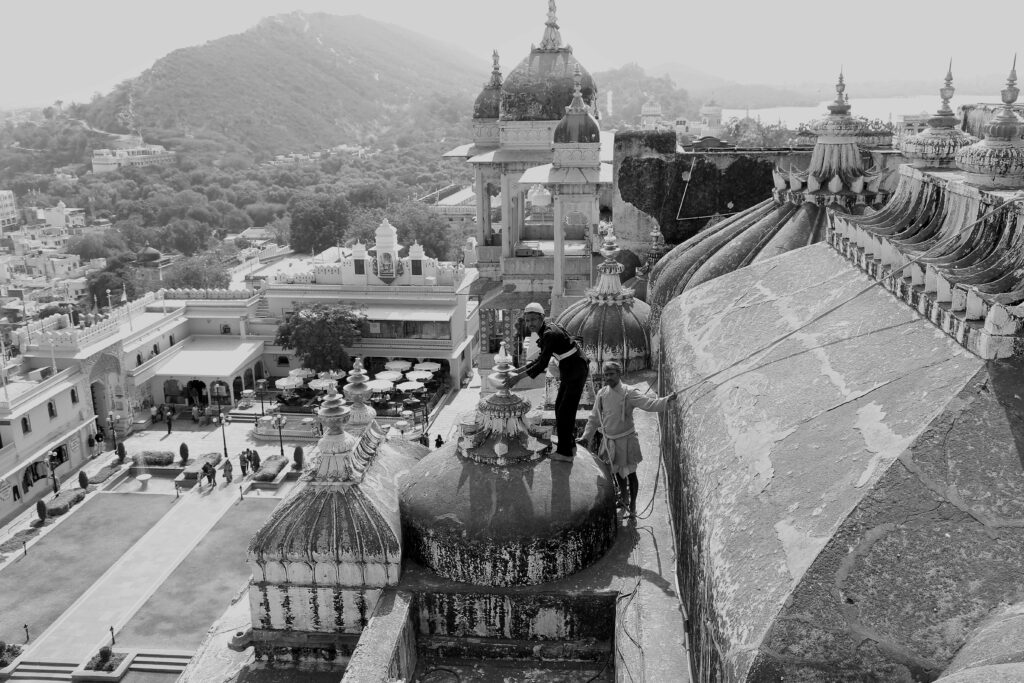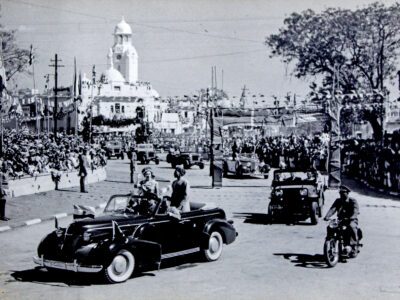The long-standing friendship between India and France was marked by a new milestone of cultural diplomacy in 2015. In April of 2015, on behalf of the City Palace of Udaipur, The Maharana of Mewar Charitable Foundation signed a partnership agreement with France’s National Estate of Chambord to promote tourism and preserve heritage. Under this initiative, rare and unpublished photographs from the City Palace of Udaipur travelled to the Chambord châteaux in 2022, to be exhibited under the title ‘Chambord – Udaipur: A Tale of Two Palaces’. It is a joint endeavour to showcase contrasts and convergences between the two royal houses, share knowledge on preservation and promote centuries-old heritage and tourism.
Photographic dialogue between Udaipur and Chambord
A captured moment, a slice of history, a celebration or a tragedy – all these come alive in images that convey more than words. Defined as ‘austere and blazing poetry of the real’, old and rare photographs in stark black and white are as real as they can get, without modern day digital interventions such as ‘Photoshop’. Standing out for their clarity of form and emotion, the 150 photographs from the City Palace Museum showcasing innovation and installation, architectural design, snapshots of everyday life and close relationship with nature are now on display alongside the photographs from Chambord. Together they bring out, in stunning detail, the lives of royalty and those that revolved around them.

Chateau de Chambord
Titled a “A Tale of Two Palaces”, the exhibition captures vignettes from the two royal houses suffused with five centuries of history. he pictures documenting their commonalities and contrasts.
History – Chateau de Chambord & The City Palace Udaipur
In 1553, the then sovereign Maharana Udai Singh II selected Udaipur as the capital of Mewar, and started building the palace complex. It was completed by his descendants in the years to come. The City Palace Udaipur has been documented via art and photography from the time it became the first palace in the world to obtain the camera obscura (dark camera) in 1818. Over time, the 30,000 photographs brought out in vivid detail lives of royalty and their celebrity guests, various ceremonies, everyday life in the palace and people who depended on it for sustenance. The Chateau de Chambord is one of the most recognisable chateaux in the world known for its distinct French Renaissance architecture built by King Francis I. Its earliest photographs were taken in the 1840s by primitive masters William Fox Talbot (with the first known photo of the Chateau) Gustave Le Grey and Albert Stapfer. Interestingly, both these beautiful palaces were constructed during the 16th century, with a 40-year interval separating them. The 19th century pictures of Chambord were taken by three generations of the Dreux family – Georges Dreux, his son Gonzague and grandson Phillipe. The family signed an agreement in 2017, with the Chambord Estate to facilitate digitalization, study and presentation of a truly remarkable collection of pictures.

City Palace
A Tale of Two Palaces
The photographs from both palaces that are on display leave us spell bound with their similarities. One such example is a photograph taken in 2016 showing the reinstallation of a metal Kalasha (finial) on a majestic dome on the Mardana Mahal Udaipur and that of a dome on the east tower of Chambord with its lead ornamentation taken between 1945-50.Other pictures that vie for attention include one of Prince Charles and Princess Diana at Chambord, of Roger Moore who shot for the Bond film ‘Odyssey’ in Udaipur, and that of Edwina Mountbatten at Jagmandir. Snapshots of life in the form of a bicycle race in the southern façade of the Chambord castle, women employees walking in the Udaipur palace, the hunting of a man- eating tiger in Udaipur, snaring scenes and the wreckage of a World War I plane before Chambord are a part of this array of pictures that bring out to perfection the grandeur of life and times of royalty in both palaces.

Architectural Conservation of North Façade, Lakshmi Chowk, Zenana Mahal
Apart from being of interest to a vast cross section of people, the ‘Chambord – Udaipur: A Tale of Two Palaces’ photography collection is also an element of both countries’ “soft power”, which scholar Joseph Nye coined to mean the power of ‘attraction of a country’s culture, political ideals and policies.’ As a major landmark in cultural diplomacy, the exhibition builds on the ancient tradition of individual explorers, travellers, traders, artistes and teachers, visiting different countries as the very first cultural diplomats. By serving as a platform for civic discourse with mutual respect and shared experiences, it fosters understanding and appreciation of architecture, history, tradition and lifestyle. Moreover, it helps pool knowledge, skills and experiences for the preservation of heritage and promotion of tourism. Diplomacy through common cultural values and legacies seen through this unique photographic dialogue is indeed the way forward.
















